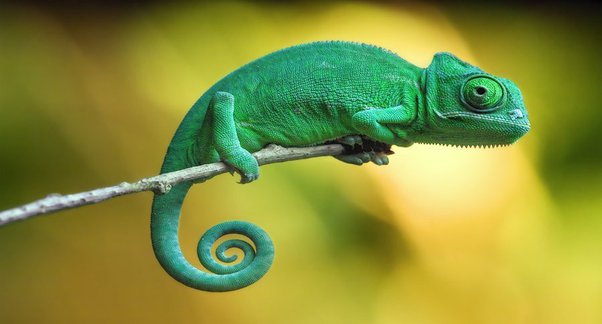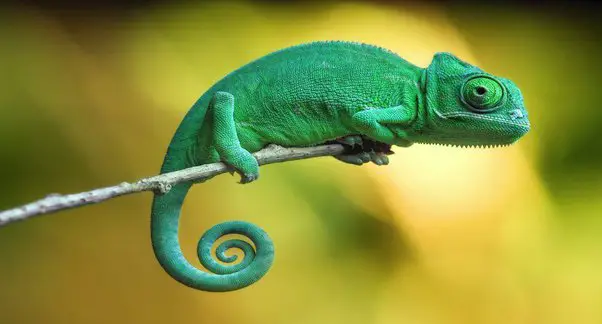Chameleons are fascinating creatures that have the ability to change their skin color to blend into their surroundings. But did you know that this is just one of the many ways they defend themselves?
When it comes to protecting themselves, chameleons have several tricks up their sleeves. From their incredible camouflage abilities to their lightning-fast tongues, these reptiles have developed some unique and effective ways to stay safe in the wild. So, let’s dive deeper into the world of chameleon self-defense and uncover some of their most impressive tactics.

How Do Chameleons Defend Themselves?
Chameleons are well-known for their ability to change colors and adapt to their surroundings. However, this is not the only way they defend themselves. In this article, we will take a closer look at the different ways chameleons protect themselves from predators.
Camouflage
One of the most well-known defense mechanisms of chameleons is their ability to change color and blend in with their surroundings. This is known as camouflage. Chameleons have special cells in their skin called chromatophores that contain different pigments. By manipulating these cells, they can change their color to match their surroundings. This helps them to remain hidden from predators.
In addition to changing color, chameleons can also change the texture of their skin to match their surroundings. For example, if they are on a rough surface, they can make their skin rough, and if they are on a smooth surface, they can make their skin smoother.
Body Language
Another way that chameleons defend themselves is through their body language. Chameleons are known for their ability to move their eyes independently of each other. This allows them to keep an eye on potential predators and threats while still appearing to be relaxed and unaware.
Chameleons also have the ability to inflate their bodies and make themselves appear larger. This can be intimidating to predators and may discourage them from attacking.
Protective Skin
Chameleons have tough, scaly skin that helps to protect them from predators. Some species of chameleons also have spines or thorns on their skin that can be painful to predators if they try to attack.
In addition to their tough skin, chameleons also have the ability to shed their skin. This helps to get rid of any parasites or bacteria that may be living on their skin and can also help to remove any injuries or damage.
Long Tongue
Chameleons have incredibly long tongues that they can shoot out at incredible speeds to catch prey. However, this tongue is also an effective defense mechanism. If a predator gets too close, the chameleon can quickly shoot out its tongue and grab the predator, giving it time to escape.
Speed and Agility
Another way that chameleons defend themselves is through their speed and agility. Chameleons are incredibly fast and can move quickly to escape predators. They are also able to climb trees and other structures quickly, making it difficult for predators to follow.
Disguise
In addition to camouflage, chameleons can also use disguise as a defense mechanism. Some species of chameleons have horns or other protrusions on their heads that can make them look like leaves or other objects in their environment. This can help to protect them from predators by making them less noticeable.
Toxic Secretions
Some species of chameleons have toxic secretions that they use to defend themselves from predators. These secretions can be released through their skin or through glands in their mouth. They can be poisonous or just foul-tasting, which can discourage predators from attacking.
Regeneration
Chameleons have the ability to regenerate certain parts of their body, including their tails. If a predator attacks and bites off their tail, the chameleon can grow a new one. This helps to protect the chameleon from further attacks and can also help to distract predators while the chameleon makes its escape.
Conclusion
Chameleons have a variety of different defense mechanisms that they use to protect themselves from predators. These include camouflage, body language, protective skin, long tongues, speed and agility, disguise, toxic secretions, and regeneration. Understanding these defense mechanisms can help us to appreciate these amazing creatures and the ways in which they have adapted to their environments.
Frequently Asked Questions
Chameleons are known for their unique ability to change their color and blend into their surroundings. However, they also have various other ways to defend themselves from predators. Here are some frequently asked questions about how chameleons protect themselves.
How do chameleons change their color?
Chameleons change their color through specialized cells in their skin called chromatophores. These cells contain pigments that can expand or contract, causing the chameleon’s skin to change color. They can change their color to blend in with their surroundings, communicate with other chameleons, and regulate their body temperature.
Chameleons can change their color rapidly, and the process is controlled by their nervous system. They can even change the color of different parts of their body independently, allowing them to create complex patterns and blend in with various backgrounds.
Do all chameleons change color?
While chameleons are known for their color-changing abilities, not all species can change color. Some chameleons, such as the Jackson’s chameleon, can only change their color slightly, while others, like the Parson’s chameleon, can change to a wide range of colors.
Chameleons that live in environments with more stable backgrounds, such as the forest floor, are less likely to change color, while those that live in more varied environments, such as tree branches, are more likely to change color.
What other ways do chameleons defend themselves?
Chameleons have various other ways to protect themselves from predators. One way is by puffing up their bodies to appear larger and more intimidating. They can also hiss, open their mouths wide, and display their brightly colored tongues, which can startle predators.
Chameleons can also use their sharp claws to defend themselves, and some species can even shoot their tongues out at high speeds to capture prey or deter predators.
Can chameleons regenerate lost limbs?
Unlike some other lizards, chameleons cannot regenerate lost limbs. However, they have a remarkable ability to heal quickly from injuries. If a chameleon loses part of its tail, for example, it can heal the wound and grow a new tail, although the new tail may be shorter and less vibrant in color.
Chameleons can also shed their skin to get rid of parasites and other irritants. This process, called ecdysis, allows them to maintain healthy skin and protect themselves from infections.
Are chameleons endangered?
Many chameleon species are threatened by habitat loss and poaching for the pet trade. Some species, such as the pygmy chameleon, are considered critically endangered, while others, like the panther chameleon, are listed as vulnerable.
Conservation efforts are underway to protect chameleons and their habitats, including breeding programs, habitat restoration, and educational campaigns to raise awareness about the importance of these unique and fascinating creatures.
Chameleons Fight To Defend Their Territory | Madagascar | BBC Earth
In conclusion, chameleons are fascinating creatures with unique defense mechanisms. They have the ability to change their skin color to blend in with their surroundings, making them difficult for predators to spot. Additionally, they have long, sticky tongues that can quickly snatch up prey or defend against attackers.
Despite their impressive abilities, chameleons still face threats in their natural habitat. Habitat loss, climate change, and the exotic pet trade are all contributing to their decline in the wild. It is important for us to protect these incredible creatures and their habitats to ensure their survival for generations to come.
Overall, chameleons are a reminder of the incredible diversity and adaptability of the natural world. By studying and protecting these unique creatures, we can gain a better understanding of the complex ecosystems that make up our planet.

